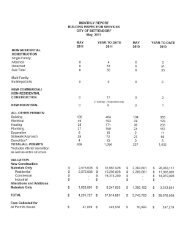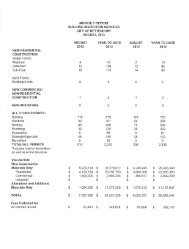All You Ever Wanted to Know About Fire Extinguishers . . .
All You Ever Wanted to Know About Fire Extinguishers . . .
All You Ever Wanted to Know About Fire Extinguishers . . .
You also want an ePaper? Increase the reach of your titles
YUMPU automatically turns print PDFs into web optimized ePapers that Google loves.
This is the new style of labeling that shows thisextinguisher may be used on Ordinary Combustibles,Flammable Liquids, or Electrical Equipment fires.This is the new labeling style with a diagonal red linedrawn through the picture <strong>to</strong> indicate what type offire this extinguisher is NOT suitable for. In thisexample, the fire extinguisher could be used onOrdinary Combustibles and Flammable Liquids fires,but not for Electrical Equipment fires.Types of <strong>Fire</strong> <strong>Extinguishers</strong>Dry Chemical extinguishers are usually rated for multiple purpose use. Theycontain an extinguishing agent and use a compressed, non-flammable gas as apropellant.Halon extinguishers contain a gas that interrupts the chemical reaction that takesplace when fuels burn. These types of extinguishers are often used <strong>to</strong> protectvaluable electrical equipment since them leave no residue <strong>to</strong> clean up. Halonextinguishers have a limited range, usually 4 <strong>to</strong> 6 feet. The initial application ofHalon should be made at the base of the fire, even after the flames have beenextinguished.Water These extinguishers contain water and compressed gas and should onlybe used on Class A (ordinary combustibles) fires.Carbon Dioxide (CO2) extinguishers are most effective on Class B and C(liquids and electrical) fires. Since the gas disperses quickly, these extinguishersare only effective from 3 <strong>to</strong> 8 feet. The carbon dioxide is s<strong>to</strong>red as a compressedliquid in the extinguisher; as it expands, it cools the surrounding air. The coolingwill often cause ice <strong>to</strong> form around the “horn” where the gas is expelled from theextinguisher. Since the fire could re-ignite, continue <strong>to</strong> apply the agent even afterthe fire appears <strong>to</strong> be out.










